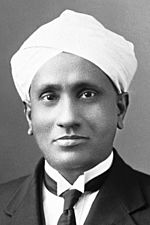Chandrasekhara Raman para niños
Datos para niños Sir Chandrasekhara Venkata Raman |
||
|---|---|---|
 Dr. Chandrasekhara Venkata Raman, en 1930.
|
||
| Información personal | ||
| Nombre en tamil | சந்திரசேகர வெங்கட ராமன் | |
| Nacimiento | 7 de noviembre de 1888 Trichinopoly, Madrás, |
|
| Fallecimiento | 21 de noviembre de 1970 Bangalore, Karnataka, |
|
| Residencia | Nueva Delhi | |
| Nacionalidad | india | |
| Religión | Hinduismo | |
| Familia | ||
| Padres | R. Chandrasekhara Iyer Parvathi Ammal |
|
| Cónyuge | Lokasundari Ammal (1907-1970) | |
| Educación | ||
| Educado en | Universidad de Calcuta | |
| Información profesional | ||
| Área | física | |
| Conocido por | Descubrir la forma de traspasar un haz de luz sobre líquidos. Efecto Raman |
|
| Empleador | Universidad de Calcuta | |
| Estudiantes doctorales | Vikram Sarabhai y G. N. Ramachandran | |
| Obras notables | efecto Raman | |
| Miembro de |
|
|
| Distinciones | Premio Nobel de Física de 1930; Premio Lenin de La Paz de 1957 entre otros más; Bharat Ratna (1954). | |
| Firma | ||
Chandrasekhara Venkata Raman (nacido el 7 de noviembre de 1888 en Trichinopoly, Madrás, y fallecido el 21 de noviembre de 1970 en Bangalore) fue un físico indio muy importante. Es famoso por descubrir el efecto Raman, un fenómeno de la luz que le valió el Premio Nobel de Física en 1930.
Contenido
Biografía de C. V. Raman
Primeros años y educación
C. V. Raman nació en Tiruchirappalli, una ciudad en la India que antes era parte de la India británica. Sus padres eran Chandrasekhara Ramanathan Iyer y Parvathi Ammal. Su padre era profesor y su familia se mudó a Visakhapatnam cuando él tenía cuatro años.
Raman fue un estudiante muy brillante desde pequeño. Terminó la escuela a los 11 años y un examen preuniversitario a los 13, obteniendo siempre las mejores calificaciones.
En 1902, Raman entró al Presidency College en Madrás. Allí, en 1904, se graduó con honores en Física e Inglés. Con solo 18 años, publicó su primer artículo científico en una revista británica llamada Philosophical Magazine. En 1907, obtuvo su maestría con las mejores notas.
Su profesor de física le animó a seguir estudiando en Inglaterra. Sin embargo, un examen médico indicó que su salud no era la mejor para el clima de allí. Por eso, Raman decidió quedarse en la India para continuar sus investigaciones.
Carrera profesional y descubrimientos
Entre 1917 y 1933, Raman fue profesor de física en la Universidad de Calcuta. Allí, su trabajo en el campo de la óptica (el estudio de la luz) fue muy reconocido. En 1919, se convirtió en secretario honorario de la Asociación India para el Progreso de las Ciencias.
Al principio, Raman investigó sobre las vibraciones y el sonido. Pero alrededor de 1920, empezó a estudiar cómo la luz se dispersa, un fenómeno llamado difracción.
En 1928, hizo su descubrimiento más famoso: el efecto Raman. Este efecto ocurre cuando la luz atraviesa un líquido o un gas transparente. Al analizar la luz que sale, se observan cambios en su frecuencia. Este descubrimiento confirmó ideas teóricas que ya existían.
Gracias a este importante hallazgo, en 1930, C. V. Raman recibió el Premio Nobel de Física. En 1929, también fue nombrado caballero (sir).
Después de 1949, fundó y dirigió el Instituto Raman de Investigación.
¿Por qué el mar es azul?
Raman también se interesó por el color azul del mar. En 1921, mientras viajaba en barco de Inglaterra a la India, observó el Mar Mediterráneo. Usando herramientas sencillas, como un espectroscopio de bolsillo, estudió el agua.
En ese momento, la explicación más aceptada sobre el color del mar era que era solo un reflejo del cielo azul. Esta idea la había propuesto Lord Rayleigh. Sin embargo, Raman notó que el mar se veía aún más azul de lo normal, incluso cuando usaba un prisma para evitar el reflejo del sol.
Cuando llegó a la India, publicó un artículo llamado El color del mar. En él, decía que la explicación de Rayleigh no era suficiente. Raman pensó que las propias moléculas de agua podían estar dispersando la luz, haciendo que el mar se viera azul.
Con la ayuda de su estudiante K. R. Ramanathan, continuó investigando. En 1922, concluyó que la dispersión de la luz por las moléculas de agua era la razón principal del color azul del mar. Hoy sabemos que el color azul del agua se debe a que las moléculas de agua absorben más las longitudes de onda de luz roja y naranja, dejando que las azules se vean.
Reconocimientos y premios
Raman recibió muchos honores a lo largo de su vida. Varias universidades le otorgaron doctorados honorarios. Fue elegido miembro de la Royal Society en 1924.
Entre sus premios más importantes se encuentran:
- El Premio Nobel de Física en 1930.
- La medalla Hughes de la Royal Society en 1930, por sus estudios sobre la dispersión de la luz.
- El premio Bharat Ratna en 1954, el premio civil más alto de la India.
- El Premio Lenin de la Paz en 1957.
Nombres en su honor
Para recordar su legado, se han nombrado varios lugares y objetos en su honor:
- Un cráter en la Luna lleva su nombre.
- El asteroide (55753) Raman también fue nombrado en su memoria.
Galería de imágenes
Véase también
 En inglés: C. V. Raman Facts for Kids
En inglés: C. V. Raman Facts for Kids


